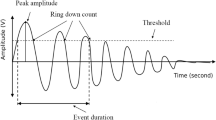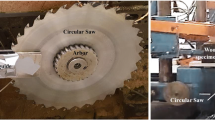Abstract
A methodology is presented for acoustic emission (AE) monitoring of Douglas fir wood in circular sawing process under extreme cutting conditions. An AE sensor was mounted on the saw guide to investigate the blade vibration, the interaction between the saw and workpiece, and the cut surface waviness. The acquired signal was filtered using a wavelet de-noising method. Signal processing was performed in both the time and frequency domains, and different features were extracted. The effects and significance of cutting parameters such as feed speed, rotation speed, and depth of cut on the AE signal were discussed. Both the statistical regression and artificial intelligence approach were employed to correlate the AE-extracted features with the cutting power and waviness. Adaptive neuro-fuzzy inference system (ANFIS) was used to predict the cutting power and waviness. Optimal feature selection was performed by combining the ANFIS with a metaheuristic optimization algorithm. Particle swarm optimization (PSO) method was used to find the AE-selected features that result in a minimum ANFIS model error. ANFIS was trained using both the PSO and a hybrid algorithm. The results indicate the effectiveness of the wavelet de-noising method for signals that are polluted by different low- and high-frequency sources. AE signals were highly influenced by the saw blade deflection and its vibration response. ANFIS modeling showed higher performance than statistical regression for cutting power and waviness prediction. Optimal feature selection improved the model accuracy, which was further enhanced when the optimal sensory features were combined with the studied cutting parameters. The optimal ANFIS performance was achieved when the network was trained using PSO algorithm. The presented methodology can successfully monitor the cut surface waviness.
Similar content being viewed by others
References
Nasir V, Cool J (2018) A review on wood machining: characterization, optimization, and monitoring of the sawing process. Wood Mater Sci Eng https://doi.org/10.1080/17480272.2018.1465465
Abellan-Nebot JV, Subirón FR (2010) A review of machining monitoring systems based on artificial intelligence process models. Int J Adv Manuf Technol 47(1–4):237–257
Teti R, Jemielniak K, O’Donnell G, Dornfeld D (2010) Advanced monitoring of machining operations. CIRP Ann. Manuf. Technol 59(2):717–739
Sutowski P, Święcik R (2018) The estimation of machining results and efficiency of the abrasive electro-discharge grinding process of Ti6Al4V titanium alloy using the high-frequency acoustic emission and force signals. Int J Adv Manuf Technol 94(1–4):1263–1282
Li X (2002) A brief review: acoustic emission method for tool wear monitoring during turning. Int J Mach Tools Manuf 42(2):157–165
Hase A, Wada M, Koga T, Mishina H (2014) The relationship between acoustic emission signals and cutting phenomena in turning process. Int J Adv Manuf Technol 70(5–8):947–955
Filippov AV, Rubtsov VE, Tarasov SY, Podgornykh OA, Shamarin NN (2018) Detecting transition to chatter mode in peakless tool turning by monitoring vibration and acoustic emission signals. Int J Adv Manuf Technol 95(1–4):157–169
Uekita M, Takaya Y (2017) Tool condition monitoring for form milling of large parts by combining spindle motor current and acoustic emission signals. Int J Adv Manuf Technol 89(1–4):65–75
Shi Z, Li Y, Liu Z, Qiao Y (2018) Determination of minimum uncut chip thickness during micro-end milling Inconel 718 with acoustic emission signals and FEM simulation. Int J Adv Manuf Technol 98(1–4):37–45
Li Z, Wang G, He G (2018) Surface quality monitoring based on time-frequency features of acoustic emission signals in end milling Inconel-718. Int J Adv Manuf Technol 96(5–8):2725–2733
Gaja H, Liou F (2016) Automatic detection of depth of cut during end milling operation using acoustic emission sensor. Int J Adv Manuf Technol 86(9–12):2913–2925
Aguilera A (2011) Cutting energy and surface roughness in medium density fiberboard rip sawing. Eur J Wood Wood Products 69(1):11–18
Aguilera A, Zamora R (2007) Wood machining process monitoring of blackwood (Acacia melanoxylon) with acoustic emission technique and his relationship with resulting surface roughness. Maderas-Cienc Tecnol 9(3):323–332
Aguilera A, Vega M, Méausoone PJ (2007) Effects of grain angle on the amplitudes of acoustic emission and surface roughness in wood machining. Wood Sci Technol 41(4):373–381
Mohammadpanah A, Lehmann B, White J (2017) Development of a monitoring system for guided circular saws: an experimental investigation. Wood Mater Sci Eng 14(2):99–106
Nasir V, Mohammadpanah A, Cool J (2018) The effect of rotation speed on the power consumption and cutting accuracy of guided circular saw: experimental measurement and analysis of saw critical and flutter speeds. Wood Mater Sci Eng https://doi.org/10.1080/17480272.2018.1508167
da Silva RHL, da Silva MB, Hassui A (2016) A probabilistic neural network applied in monitoring tool wear in the end milling operation via acoustic emission and cutting power signals. Mach Sci Technol 20(3):386–405
Juan J (1992) Comment bien usiner le bois. CTBA, Paris, p 140
Sutowski P, Święcik R (2018) The estimation of machining results and efficiency of the abrasive electro-discharge grinding process of Ti6Al4V titanium alloy using the high-frequency acoustic emission and force signals. Int J Adv Manuf Technol 94(1–4):1263–1282
Klink A, Holsten M, Schneider S, Koshy P (2016) Acoustic emission signatures of electrical discharge machining. CIRP Ann 65(1):229–232
Zhang D, Bi G, Sun Z, Guo Y (2015) Online monitoring of precision optics grinding using acoustic emission based on support vector machine. Int J Adv Manuf Technol 80(5–8):761–774
Wang B, Liu Z (2017) Acoustic emission signal analysis during chip formation process in high speed machining of 7050-T7451 aluminum alloy and Inconel 718 superalloy. J Manuf Process 27:114–125
Griffin JM, Diaz F, Geerling E, Clasing M, Ponce V, Taylor C, Turner S, Michael EA, Mena FP, Bronfman L (2017) Control of deviations and prediction of surface roughness from micro machining of THz waveguides using acoustic emission signals. Mech Syst Signal Process 85:1020–1034
Gaja H, Liou F (2016) Automatic detection of depth of cut during end milling operation using acoustic emission sensor. Int J Adv Manuf Technol 86(9–12):2913–2925
Kishawy HA, Hegab H, Umer U, Mohany A (2018) Application of acoustic emissions in machining processes: analysis and critical review. Int J Adv Manuf Technol 98(5–8):1391–1407
Chen GS, Zheng QZ (2018) Online chatter detection of the end milling based on wavelet packet transform and support vector machine recursive feature elimination. Int J Adv Manuf Technol 95(1–4):775–784
Pour M (2018) Determining surface roughness of machining process types using a hybrid algorithm based on time series analysis and wavelet transform. Int J Adv Manuf Technol 97(5–8):2603–2619
Tangjitsitcharoen S, Lohasiriwat H (2018) Intelligent monitoring and prediction of tool wear in CNC turning by utilizing wavelet transform. Int J Adv Manuf Technol 99(9–12):2219–2230
Benkedjouh T, Zerhouni N, Rechak S (2018) Tool wear condition monitoring based on continuous wavelet transform and blind source separation. Int J Adv Manuf Technol 97(9–12):3311–3323
Goli G, Fioravanti M, Marchal R, Uzielli L, Busoni S (2010) Up-milling and down-milling wood with different grain orientations–the cutting forces behaviour. Eur J Wood Wood Prod 68(4):385–395
Zhu K, San Wong Y, Hong GS (2009) Wavelet analysis of sensor signals for tool condition monitoring: a review and some new results. Int J Mach Tools Manuf 49(7–8):537–553
Jang J (1993) ANFIS: adaptive network-based fuzzy inference systems. IEEE Trans Syst Man Cybern 23:665–685
Sugeno M (1985) Industrial applications of fuzzy control. Elsevier, Amsterdam
Jain V, Raj T (2018) Prediction of cutting force by using ANFIS. Int J Syst Assur Eng Manag 9(5):1137–1146
Shivakoti I, Kibria G, Pradhan PM, Pradhan BB, Sharma A (2019) ANFIS based prediction and parametric analysis during turning operation of stainless steel 202. Mater Manuf Process 34(1):112–121
Moreira LC, Li WD, Lu X, Fitzpatrick ME (2019) Supervision controller for real-time surface quality assurance in CNC machining using artificial intelligence. Comput Ind Eng 127:158–168
Maher I, Eltaib MEH, Sarhan AA, El-Zahry RM (2014) Investigation of the effect of machining parameters on the surface quality of machined brass (60/40) in CNC end milling—ANFIS modeling. Int J Adv Manuf Technol 74(1–4):531–537
Nguyen D, Yin S, Tang Q, Son PX (2019) Online monitoring of surface roughness and grinding wheel wear when grinding Ti-6Al-4V titanium alloy using ANFIS-GPR hybrid algorithm and Taguchi analysis. Precis Eng 55:275–292
DuyTrinh N, Shaohui Y, Nhat Tan N, Xuan Son P, Duc LA (2019) A new method for online monitoring when grinding Ti-6Al-4V alloy. Mater Manuf Process 34(1):39–53
Masoudi S, Sima M, Tolouei-Rad M (2018) Comparative study of ANN and ANFIS models for predicting temperature in machining. J Eng Sci Technol 13(1):211–225
Kennedy J, Eberhart RC (1995) Particle swarm optimization. In: IEEE internal conference on neural networks. Perth, Australia, 4: 942–1948
Esmin AA, Coelho RA, Matwin S (2015) A review on particle swarm optimization algorithm and its variants to clustering high-dimensional data. Artif Intell Rev 44(1):23–45
Kennedy J, Eberhart RC, Shi Y (2001) Swarm intelligence. Morgan Kaufmann, Los Altos
Alexandre FA, Lopes WN, Dotto FRL, Ferreira FI, Aguiar PR, Bianchi EC, Lopes JC (2018) Tool condition monitoring of aluminum oxide grinding wheel using AE and fuzzy model. Int J Adv Manuf Technol 96(1–4):67–79
Nasir V, Nourian S, Avramidis S, Cool J (2019) Stress wave evaluation by accelerometer and acoustic emission sensor for thermally modified wood classification using three types of neural networks. Eur J Wood Wood Prod 77(1):45–55
Nasir V, Nourian S, Avramidis S, Cool J (2019) Classification of thermally treated wood using machine learning techniques. Wood Sci Technol 53(1):275–288
Funding
This work was funded by the Natural Sciences and Engineering Research Council of Canada (NSERC) (Grant No. RGPIN-2015-03653).
Author information
Authors and Affiliations
Corresponding author
Ethics declarations
Conflicts of interest
The authors declare that they have no conflict of interest.
Additional information
Publisher’s note
Springer Nature remains neutral with regard to jurisdictional claims in published maps and institutional affiliations.
Rights and permissions
About this article
Cite this article
Nasir, V., Cool, J. & Sassani, F. Acoustic emission monitoring of sawing process: artificial intelligence approach for optimal sensory feature selection. Int J Adv Manuf Technol 102, 4179–4197 (2019). https://doi.org/10.1007/s00170-019-03526-3
Received:
Accepted:
Published:
Issue Date:
DOI: https://doi.org/10.1007/s00170-019-03526-3




